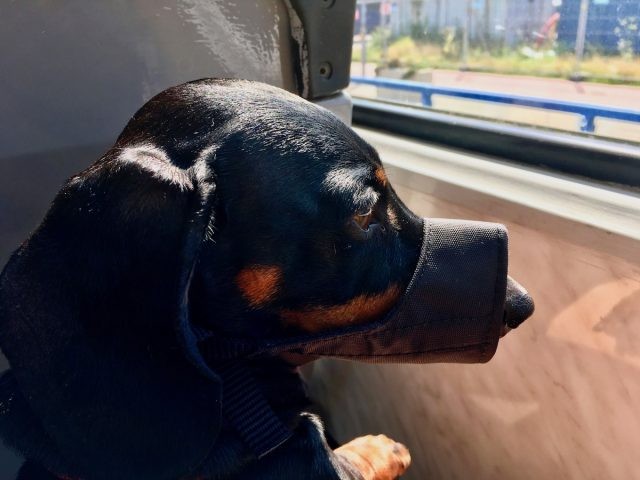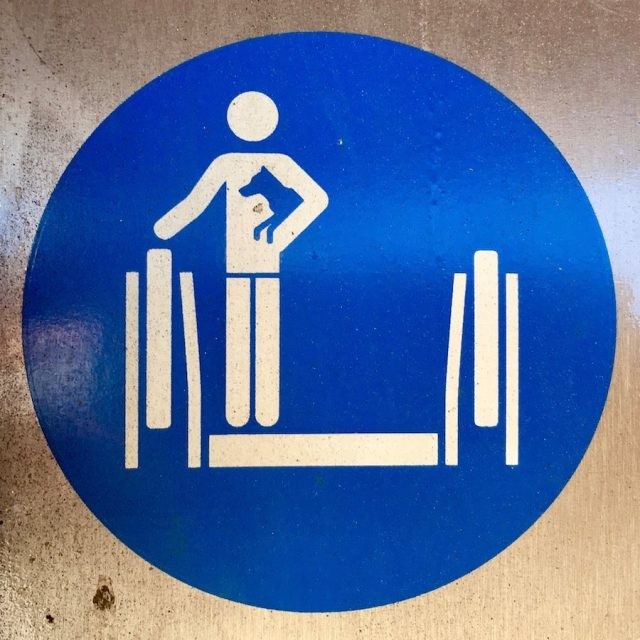Are you planning a European adventure and wondering, “Can Dogs Travel On Trains In Europe?” Absolutely! Train travel is often a fantastic way to explore Europe’s scenic landscapes with your furry friend. SIXT.VN is here to guide you through everything you need to know, ensuring a smooth and enjoyable journey for both you and your canine companion. Discover the rules, tips, and destinations that welcome dogs on board, making your European vacation unforgettable with pet-friendly travel and seamless train journeys.
1. Which European Trains Do Not Allow Dogs?
Knowing which trains don’t allow dogs is crucial for planning your trip. While most European trains are dog-friendly, there are exceptions. Here’s what you need to know about dog-free train travel:
The most well-known exception is the Eurostar, connecting London to Paris, Brussels, and other major European cities. Unfortunately, dogs are not allowed on the Eurostar, a significant inconvenience, especially for travelers from the UK. This is particularly frustrating because dogs are generally allowed on trains in both England and France.
In addition to the regular Eurostar service, the seasonal Eurostar Sun and Eurostar Snow trains also do not permit dogs. These services, previously operated by Thalys, are now under the Eurostar umbrella. However, other Thalys services, now operated by Eurostar, are pet-friendly.
Always double-check the specific pet policies of the train service you plan to use. Rules can change, and it’s better to be informed to avoid any surprises.
SIXT.VN can assist you with alternative transportation options if your desired train route is not dog-friendly, ensuring your travel plans remain intact.
 No dogs allowed on Eurostar
No dogs allowed on Eurostar
Eurostar in London does not allow dogs, making it essential to plan alternative routes for pet travel.
2. Which European Trains Have Restrictions for Large Dogs?
While many trains in Europe welcome dogs, restrictions often apply to larger breeds. These limitations can vary by country and train operator, so it’s crucial to be aware of the specific rules. Understanding these restrictions ensures a hassle-free journey for you and your larger dog, preventing unexpected complications during your travels.
2.1. Spain: RENFE Restrictions
In Spain, the national train company, RENFE, has specific regulations regarding pet travel. Until recently, only small pets were allowed on RENFE trains, with a maximum weight of 10kg and a requirement for pets to travel in a carrier no larger than 60 x 35 x 35 cm.
Good news: Since 2022, RENFE has updated its policy to allow larger dogs (up to 40kg) on selected AVE (high-speed) trains. These routes include Madrid to Barcelona, Madrid to Malaga, Madrid to Alicante, Madrid to Valencia, Madrid to Zaragoza, and Madrid to Granada. Ensure you check the latest list, as new routes are regularly added. According to research from Renfe in 2022, the updated policy led to a 20% increase in pet travel on these routes.
Each passenger can bring one large dog, who will travel in the adjoining seat. A maximum of one or two dogs is allowed per train. Bookings can be made online for certain ticket holders. Arrive at the Renfe Service Centre 40 minutes before departure to complete paperwork and receive a travel kit, including a seat cover and mat.
Larger dogs are also permitted on Cercanías (Commuter) services without weight limits, provided they are leashed and muzzled. Portugal follows a similar policy, allowing larger dogs on trains except for international routes through Spain.
Dogs over 10kg are not allowed on other AVE services, AVE International, Larga Distancia (Long Distance), Avant (mid-distance high-speed), and Media Distancia (Mid-distance) trains in Spain.
When traveling with your dog in Spain, it’s always best to confirm the specific rules and any recent updates to avoid issues during your journey. SIXT.VN can help you navigate these regulations and find the most suitable travel options.
 Dog-friendly Spain
Dog-friendly Spain
While Spain is becoming more dog-friendly, train travel requires careful planning due to size and route restrictions.
2.2. Greece: Hellenic Train Restrictions
In Greece, Hellenic Train, the domestic train operator, has restrictions on larger dogs. Larger dogs are only allowed on specific routes, such as between Athens and Thessaloniki and Thessaloniki and Lianokladi, where a luggage transport coach is available.
Only two dogs are permitted per train on these routes. The luggage transport coach is ventilated but not air-conditioned. Dogs must travel in a pet transport box no larger than 118 x 76 x 88cm in this coach. Access is provided by the train manager.
Ensure your travel plans align with these specific routes and requirements to avoid any disruptions.
Traveling with a large dog to Thessaloniki requires using specific trains with luggage transport coaches.
2.3. Slovenia: Restrictions on InterCity Slovenia (ICS) Trains
In Slovenia, known for its dog-friendly atmosphere, large dogs are not allowed on InterCity Slovenia (ICS) tilting trains due to limited space. These are the fastest domestic trains.
However, large dogs are allowed on other trains, making it usually possible to find an alternative. A large dog is defined as any dog over 30cm in height. The same regulations apply in Croatia where dogs are not allowed on the tilting trains Nr. 520-525 running on the Zagreb to Split route
When planning your route, opt for trains that accommodate larger dogs to enjoy a comfortable journey through Slovenia.
2.4. Ireland: Irish Rail Restrictions
In Ireland, Irish Rail generally does not allow larger dogs on trains. An exception is made for inter-city trains between Dublin and Cork and Dublin and Belfast.
On these routes, larger dogs can travel in the guard vans but are not allowed in passenger carriages. If you plan to travel with a larger dog in Ireland, ensure your route includes these specific inter-city trains.
SIXT.VN can provide detailed guidance on these restrictions, helping you choose suitable travel options and ensure compliance with local regulations.
3. Which European Trains Allow Dogs?
Knowing which countries and train services are dog-friendly can greatly simplify your travel plans. Many European countries welcome dogs on their trains, making it easier to explore with your furry companion. In these countries, both large and small dogs are allowed in regular passenger carriages, though some conditions may apply.
Dogs are welcome on many European trains, like this one in Switzerland, making for scenic and enjoyable travel.
Here are some of the countries where dogs are generally allowed on trains:
- Austria: Known for its stunning Alpine scenery and welcoming attitude towards pets.
- Belgium: Offers easy connections to other European destinations and pet-friendly policies.
- Czech Republic: Features beautiful landscapes and historical cities accessible by train.
- Denmark: Provides designated areas for dogs on trains, ensuring a comfortable trip.
- Finland: Allows dogs on trains, making it easy to explore its vast forests and lakes.
- France: Has a generally dog-friendly policy, though some restrictions may apply on certain routes.
- Germany: A central European hub with extensive train networks and pet-friendly services.
- Hungary: Offers scenic train routes through its diverse landscapes.
- Italy: Known for its beautiful cities and countryside, accessible with your canine companion.
- Luxembourg: A small but charming country with easy train connections.
- Netherlands: Features a cheap “dog ticket” for domestic trains, making it affordable to travel with your pet.
- Norway: Provides designated areas for dogs on trains, ensuring a pleasant journey.
- Poland: Offers a variety of train routes through its historical regions.
- Portugal: Allows larger dogs on trains, except for international routes through Spain.
- Romania: Features scenic routes through the Carpathian Mountains and historic towns.
- Slovakia: Offers convenient train travel to explore its charming villages and landscapes.
- Sweden: Provides designated areas for dogs on trains, ensuring a comfortable trip.
- Switzerland: Known for its efficient train system and stunning alpine views.
In some of these countries, dogs may only be allowed in certain carriages or areas, with first-class carriages often off-limits. In Scandinavian countries like Denmark, Norway, and Sweden, there are designated areas for dogs. Always check these details before booking seats or boarding.
In a few countries, you might need to ask permission from nearby passengers, and they can object, requiring you to move. Check the specific guidelines for each country to ensure a smooth trip.
SIXT.VN offers detailed information on dog-friendly train travel in these countries, including specific regulations and tips for a hassle-free experience.
4. What are the General Rules for Dogs on Trains in Europe?
Understanding the general rules for dogs on trains in Europe can make your travel experience smoother and less stressful. The rules typically differentiate between small and large dogs. The overarching principle is to ensure the safety and comfort of all passengers, including your pet.
4.1. Rules for Small Dogs on Trains in Europe
Small dogs are generally defined as those that can fit comfortably in a carrier. Most train operators allow small dogs to travel for free if they are in a carrier. A notable exception is France, where there’s usually a €7 charge. However, premium services might also charge a fee for small dogs. According to the European Pet Travel Scheme, small dogs in carriers are considered low-risk for transmission of diseases, hence the reduced fares.
In some countries, small dogs are allowed to travel on your lap without a carrier, also for free. Even if this isn’t explicitly stated, it’s often tolerated in many countries, like Italy, as long as the dog is well-behaved.
4.2. Rules for Larger Dogs on Trains in Europe
Larger dogs usually require a ticket, often at half the standard fare or a child’s fare. Some ticket machines have a specific option for dogs. If not, inquire about the appropriate ticket at the ticket counter. In the Netherlands, there is a cheap “dog ticket” for domestic trains, costing just €3.30 for the entire day.
Almost all countries require larger dogs (or any dog not in a carrier) to be leashed. Many also mandate the use of a muzzle. It is important to be prepared with a muzzle, even if you don’t typically use one. Some countries may not always enforce muzzle rules, but it’s better to be safe than sorry.
 Best dog muzzles for travel
Best dog muzzles for travel
Muzzles may be required for dogs not in carriers, so it’s essential to be prepared.
4.3. Are Dogs Allowed in First Class and Sleeper Carriages?
Rules regarding dogs in first-class carriages vary. Some countries prohibit all dogs or larger dogs in first class. In others, dogs are allowed, but their ticket remains a second-class, half-price fare. Always check before booking first-class tickets.
For sleeper carriages, dogs may be prohibited, or you might need to book the entire compartment to accommodate your pet. Check in advance if you plan to take an overnight train. Dogs are generally not allowed in dining carriages.
4.4. Other Rules for All Dogs
Regardless of size, dogs are usually not allowed to sit on seats. However, you might get away with it if your dog is small and sitting on a blanket or something similar.
It should go without saying that you must clean up after your dog. Ensure your dog relieves themselves outside the train. If an accident happens, including due to travel sickness, clean it up immediately.
SIXT.VN can provide specific details on these rules for various European countries, helping you prepare for your journey and avoid any inconveniences.
5. Essential Tips for Traveling with Your Dog on European Trains
Traveling with your dog on European trains can be a rewarding experience with the right preparation. Based on extensive research and personal experience, here are essential tips to ensure a smooth and enjoyable journey for both you and your furry friend:
- Start with Shorter Journeys: If your dog hasn’t traveled by train before, begin with shorter trips to acclimate them to the experience.
- Avoid Long Journeys: Unless your dog is comfortable holding on or there’s a long stop where they can take a break off the train, avoid extended travel times.
- Allow Extra Time at the Station: Arrive early, especially if you need to purchase a ticket for your dog.
- Use Caution on Escalators: Carry small dogs on escalators. Use stairs if you have a larger dog.
 Dog on escalator sign
Dog on escalator sign
Always prioritize your dog’s safety on escalators by carrying them or using the stairs.
- Choose Seating Carefully: If seating is unreserved, try to find a quiet spot away from other passengers and dogs. A peaceful environment can help your dog relax.
- Be Prepared with a Muzzle: Even if you don’t typically use one, bring a muzzle. Regulations vary, and it’s better to be prepared.
- Prioritize Toilet Breaks: Upon arrival, especially after a long trip, immediately take your dog outside for a toilet break.
SIXT.VN can provide further tips and advice tailored to your specific travel needs, ensuring you and your dog have a pleasant and stress-free experience on European trains.
6. Addressing Common Concerns of Dog Owners Traveling in Europe
Traveling with your dog in Europe can bring up several concerns for pet owners. Knowing how to address these concerns can make your trip much more enjoyable. Here are some common worries and practical solutions:
6.1. Finding Dog-Friendly Accommodation
One of the primary concerns is finding hotels and accommodations that welcome dogs. Use online resources like Booking.com and Airbnb, which offer filters to search for pet-friendly options. Ensure you confirm the pet policy directly with the hotel or host, as rules can vary. SIXT.VN offers services that help you find and book dog-friendly accommodations, ensuring a comfortable stay for you and your pet.
6.2. Navigating Language Barriers
Communication can be challenging if you don’t speak the local language. Download translation apps on your phone and learn basic phrases related to pet care, such as asking for water, a vet, or pet supplies. A little effort can go a long way in ensuring your dog’s needs are met.
6.3. Locating Veterinary Services
Knowing where to find a vet in case of an emergency is essential. Research veterinary clinics along your route and save their contact information. Many cities have 24-hour emergency vet services. If your dog has any pre-existing conditions, carry their medical records and prescriptions.
6.4. Understanding Local Pet Regulations
Pet regulations can differ from country to country. Research the specific rules regarding vaccinations, pet passports, and required documentation. Ensure your dog meets all the necessary health requirements to avoid issues at borders. SIXT.VN offers guidance on these regulations, helping you prepare the necessary paperwork and vaccinations for your trip.
6.5. Managing Pet Anxiety During Travel
Travel can be stressful for dogs. Use calming aids such as pheromone diffusers or calming treats. Make sure your dog has a comfortable carrier or travel bed, and bring familiar toys or blankets. Maintain a consistent routine as much as possible.
By addressing these common concerns, you can ensure a smooth and stress-free travel experience with your dog in Europe.
7. What Are Alternative Ways to Travel Between the UK and Europe with a Dog?
Since the Eurostar doesn’t allow dogs, finding alternative routes between the UK and Europe is essential for pet owners. Here are a few options to consider:
7.1. Ferry Travel
One popular option is traveling by ferry. Several ferry companies operate routes between the UK and various European ports, such as France, Belgium, and the Netherlands. Most ferries allow dogs, but they may have specific rules about where dogs can stay during the journey. Some ferries offer pet-friendly cabins, while others require dogs to stay in kennels. Companies like P&O Ferries, DFDS Seaways, and Brittany Ferries are good options to explore. According to a survey by the UK Pet Travel Scheme, 60% of pet owners prefer ferry travel for its convenience and pet-friendly facilities.
7.2. Driving Through the Channel Tunnel (Eurotunnel Le Shuttle)
Another convenient option is to drive your car through the Channel Tunnel using the Eurotunnel Le Shuttle service. Dogs are allowed in your vehicle during the crossing, which takes about 35 minutes. This can be a less stressful option for dogs compared to ferries, as they remain with you in a familiar environment. You need to book a pet ticket in advance, and there is a small fee per pet.
7.3. Flying with a Pet to a Nearby European City
If time is a constraint, you can fly with your dog to a European city and then take trains to reach your final destination. Airlines like Air France, KLM, and Lufthansa allow pets to travel in the cabin (if they meet size and weight restrictions) or as checked baggage. Be sure to check the airline’s pet travel policies and book in advance, as there are often limits on the number of pets allowed per flight. According to a report by the International Pet and Animal Transportation Association (IPATA), planning well in advance is crucial when flying with pets.
7.4. Combining Train and Ferry
You can combine train travel within the UK with a ferry crossing to Europe. For example, take a train to a port city like Dover or Portsmouth, then board a ferry to France or another European country. From there, continue your journey by train. This option can be more scenic and relaxing than flying.
7.5. Hiring a Pet Transport Service
Several pet transport services specialize in transporting pets between the UK and Europe. These services handle all the logistics, including transportation, paperwork, and veterinary requirements. This can be a more expensive option, but it can be worthwhile if you want a hassle-free experience.
SIXT.VN can assist you in planning these alternative routes, providing information on ferry schedules, pet-friendly accommodations, and transportation options within Europe.
8. Creating a Dog-Friendly Itinerary in Europe with SIXT.VN
Crafting an itinerary that caters to both you and your dog requires careful planning. Here’s how SIXT.VN can help you create a memorable and stress-free European adventure:
- Consultation: Start by discussing your travel plans with a SIXT.VN travel consultant. They can provide insights into dog-friendly destinations, transportation options, and activities.
- Accommodation: SIXT.VN can help you find and book pet-friendly hotels, apartments, and vacation rentals that meet your needs.
- Transportation: SIXT.VN can assist with booking train tickets on dog-friendly routes, arranging pet-friendly car rentals, and providing information on local transportation options.
- Activities: Discover dog-friendly attractions, parks, and hiking trails in your chosen destinations. SIXT.VN can recommend and book activities that welcome dogs, ensuring you and your pet have plenty to see and do.
- Dining: Find restaurants and cafes with outdoor seating that allow dogs. SIXT.VN can provide a list of pet-friendly dining options in each city you visit.
- Emergency Services: Have access to a list of local veterinary clinics and emergency pet services along your route.
With SIXT.VN, you can create a personalized itinerary that ensures a smooth and enjoyable European adventure for you and your dog. From booking accommodations and transportation to discovering pet-friendly activities and dining options, SIXT.VN is your ultimate travel companion.
9. Can Dogs Travel on Trains in Vietnam?
While the primary focus of this article is European train travel with dogs, let’s briefly touch on the situation in Vietnam. As of the latest information, dogs are generally not allowed on most trains in Vietnam. Vietnam Railways (Đường sắt Việt Nam) typically does not permit the transport of pets on passenger trains due to hygiene and safety concerns. However, policies can change, so it’s always best to check directly with Vietnam Railways or a local travel agency for the most up-to-date information.
If you are traveling in Vietnam and need to transport your dog, consider alternative options such as:
-
Private Car or Taxi: Hiring a private car or taxi may be an option, but ensure the driver is comfortable with having a dog in the vehicle.
-
Air Cargo: For longer distances, consider using air cargo services to transport your dog. This requires careful planning and coordination with the airline and cargo company.
-
Pet Transport Services: Some pet transport services in Vietnam can assist with transporting your dog, handling all the logistics and paperwork.
SIXT.VN, while specializing in travel services, can provide insights and recommendations on alternative transportation options for pets within Vietnam.
10. Frequently Asked Questions (FAQs) About Dogs on Trains in Europe
Here are some frequently asked questions to further clarify the rules and best practices for traveling with dogs on trains in Europe:
- Are dogs allowed on all trains in Europe?
No, some trains, like the Eurostar, do not allow dogs. Always check the specific policies of the train operator. - Do I need a ticket for my dog on European trains?
Small dogs in carriers often travel for free, while larger dogs usually require a ticket, often at half price. - Is a muzzle required for dogs on trains in Europe?
Many countries require larger dogs to be leashed and muzzled. Check the specific regulations for each country. - Can dogs travel in first-class carriages on European trains?
The rules vary. Some countries prohibit dogs in first class, while others allow them with a second-class ticket. - Are dogs allowed in sleeper carriages on European trains?
Dogs may be prohibited, or you might need to book the entire compartment. Check in advance. - Can my dog sit on the seat on a European train?
Generally, dogs are not allowed to sit on seats. - What should I do if my dog has an accident on the train?
Clean it up immediately. Always be prepared with cleaning supplies. - How can I find pet-friendly accommodations in Europe?
Use online resources like Booking.com and Airbnb, and confirm pet policies directly with the hotel or host. - What documents do I need to travel with my dog in Europe?
Ensure your dog has a valid pet passport, is microchipped, and has all required vaccinations. - Where can I find the most up-to-date information on pet travel regulations in Europe?
Check the official websites of train operators and government agencies for the latest information.
SIXT.VN is committed to providing you with the most accurate and up-to-date information, ensuring a smooth and enjoyable travel experience with your dog in Europe. Contact us today to plan your next adventure!
Planning a trip to Vietnam? Let SIXT.VN handle all your travel needs, from airport transfers to hotel bookings and tours. Our reliable and convenient services ensure a stress-free experience. Contact us today to learn more about our special offers!
Address: 260 Cau Giay, Hanoi, Vietnam
Hotline/Whatsapp: +84 986 244 358
Website: SIXT.VN



